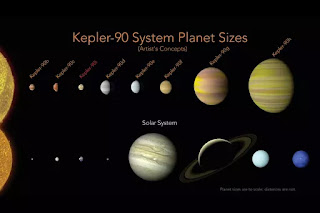NASA has discovered an eighth planet around a distant star,which means we’re no longer the largest solar system we know of. The discovery was made thanks to some artificial intelligence help from Google, which observed the planet by scouring previously left out “weak” signals in information captured by way of the Kepler space Telescope. The newly observed planet is placed in the solar system around Kepler-ninety, a star approximately 2,500 light-years far away from Earth that was previously discovered in 2014.
The Kepler space Telescope has been searching the galactic sky for exoplanets, or planets out of our own solar system, since it launched in 2009. In order to sift through all the data that it’s captured since that launch, scientists usually look at the strongest signals first. NASA has confirmed 2,525 exoplanets in that time, quite a number that has modified our understanding of the way not unusual it is to locate planets across the stars that make up our galaxy.
These days, though, artificial intelligence has come to be a more prominent tool in astronomy. Scientists — including ones who work on the Kepler data — have increasingly turned to machine learning to help sort through typically lower-priority data to see what they might have missed. In the process, they found an overlooked planet that’s now named Kepler-90i.
But while we now realize that Kepler-90 has the same wide variety of orbiting planets as our sun, the solar system is a poor candidate in the search for extraterrestrial life — or at least, life as we know it (especially compared to something like the planets that surround TRAPPIST-1). Kepler-90 is about 20% bigger and 5% warmer than our sun. And its eight planets dance around the star in much closer orbits than the ones in our own Solar System. In fact, their orbits are so comparatively small that seven of Kepler-90’s eight planets would fit in between the Earth and the Sun.
the discovery of Kepler-90i, got here after NASA permit Google teach its device learning algorithms on 15,000 signals from potential plants in the Kepler database. The scientists then took the trained system andset it to work on data from 670 stars that were already known to have multiple planets, as they considered the ones to be the most likely hiding locations. The newly found planet in Kepler-90, along side another discovered inside the Kepler-80 sun system announced today, are the first NASA become capable of verify from these new results from Google’s AI.
The inclusion of machine learning on this process shouldn’t scare humans whose livelihood revolves round discovering and studying exoplanets, according with Chris Shallue, a senior Google AI software engineer who worked on the project.
“What we’ve developed here is a tool to help astronomers have more impact,” Shallue said on a conference call about the news. “It’s a way to increase the productivity of astronomers. It certainly won’t replace them at all.”











No comments:
Post a Comment